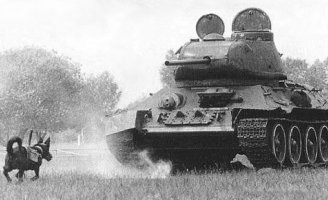© 2006 All Rights Reserved. Do not distribute or repurpose this work without written permission from the copyright holder(s).
Printed from https://danginteresting.com/let-slip-the-dogs-of-war/

The Nazi Blitzkrieg was a revolution in warfare that forced the rest of the world into a wild scramble to figure out how to dam the onslaught. The German tanks were fast and powerful, and very difficult for the conventional weapons of 1939 to repel. They rolled over Poland with nary a problem, and soon overran most all of Europe.
But forward-thinking members of the Soviet military had been contemplating the issue of warring with tanks for some time, and they had a plan: they were going to sic dogs on them.
So far as the wars of men go, dogs have always been tossed the short end of the stick. Nary does a modern movie depict the way the Romans used mastiffs with razored collars in battle, nor the fully armored Death Hounds (I didn’t make up the name) that the medieval knights would loose on a field to snap at the legs of opponents and dispatch the wounded that littered the ground. In fact, dogs have fought alongside their masters through most of recorded history. At the eve of World War II, the Soviets had a assembled a fully operational four-legged fighter division. A dog with a bomb is a potent foe.
The Soviets were unable to address the looming tank problem with any new technologies right away, thus they were forced to contemplate tackling the issue with the means at hand. Landmines were a viable option, but because one couldn’t count on the Nazis seeking out the stationary mines, they had to figure a way to make the mines seek the tanks.
The answer laid in the dog division. The trainers would starve the dogs, then train them to look for food underneath a tank. The dogs quickly learned that being released from their pens meant to run out to where the training tank was parked, where they would find a feast of vittles. Once trained, the dogs were fitted with a dog-sized backpack bombs, and let loose in a field of oncoming German Panzers. The idea was that each dog would clamber underneath an enemy tank—where there was no protective armor—where the bomb would detonate and gut the enemy vehicle.

Realization of that plan was a little less successful. The dogs had been trained to look under a Soviet tank for food, and would sometimes be loosed into a battle just to turn around and find a friendly tank to climb under. Sometimes the dogs would spook at the rumble of a running diesel engine and simply run away from the battle. Sometimes the dogs just decided they didn’t want to go anywhere, and cowered in their pens.
Despite these problems, the Anti-tank dogs were successful at disabling a reported 300 Nazi tanks throughout the war. It was enough of a problem to the Nazi advance that the Germans were compelled to attempt measures at stopping them. The top mounted machine gun proved ineffective due to the relatively small size and high speed of the targets, the fact that there were low to the ground and hard to spot, and that dogs just don’t want to die when they think they’re close to food. Orders were dispatched that commanded every German soldier to shoot any dogs on sight for fear they might be rabid. Eventually the Germans began using flame-throwers on the tanks to ward the dogs away, and these were much more successful at dissuading the attacks—but some hungry dogs would stop for neither fear of the fire nor actually being burned.
However, in 1942 one use of the Anti-tank dogs went seriously awry when a large contingent of anti-tank dogs scattered and ran amok upon being released, thus endangering everyone in the battle, and forcing the retreat of the entire Soviet tank division. Soon afterward the Anti-tank dogs were pulled from service.
The animals weren’t altogether out of the war, however. By the end, various canine soldiers were credited with having 61,000 fighting at the front lines, the delivery of 2,000 dispatches, the laying of 7,883 kilometers of telephone cable, and the rescue of 680 wounded soldiers.
© 2006 All Rights Reserved. Do not distribute or repurpose this work without written permission from the copyright holder(s).
Printed from https://danginteresting.com/let-slip-the-dogs-of-war/
Since you enjoyed our work enough to print it out, and read it clear to the end, would you consider donating a few dollars at https://danginteresting.com/donate ?